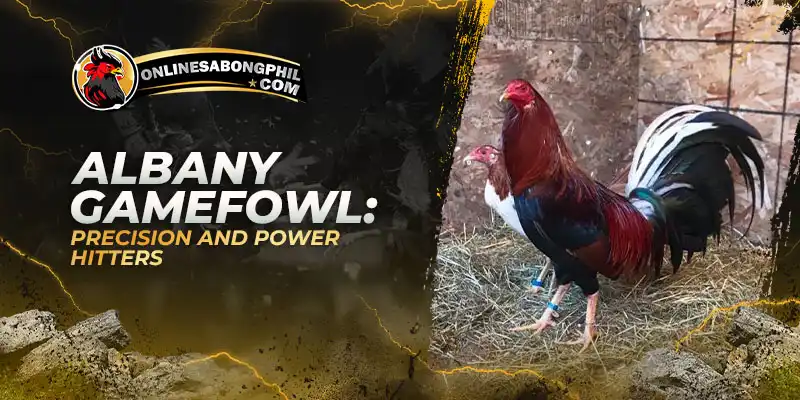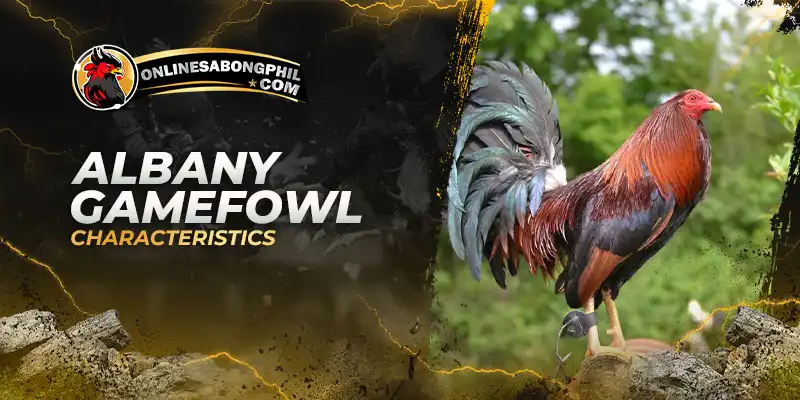The Albany Gamefowl is a breed of gamecock originating in Eastern New York. Its origins trace back to a breeder named Mr. Hatch, who had yellow-legged and green-legged cocks stolen. Bred with other New York area strains like Hardy Mahoganies and Hatch fowl, the Albany is known for its deep gamefowl qualities, uniformity, and tenacious fighting ability. In recent years, the breed has gained popularity among breeders interested in its history and unique characteristics. Albany Gamefowl often features pea combs, dark hackle feathers, and distinctive yellow legs inherited from the stolen cocks.
Albany Gamefowl History
The Albany Gamefowl emerged in Albany, New York, during the mid-to-late 1800s. The breed’s origins are linked to a breeder named Mr. Hatch, whose stolen roosters contributed significantly to the Albany bloodline. There’s no single-origin breed; Albanys were developed through a blend of various gamefowl, likely including Irish Greys, Old English Games, and others.
Breeders focused on enhancing the birds’ gameness (fighting spirit) and incorporated other New York strains, leading to a surprisingly uniform breed known for its intelligence and hard-hitting style. While historically associated with cockfighting, modern breeders often focus on preserving the Albany bloodline for its historical significance and unique traits, with an emphasis on ethical practices.
Albany Gamefowl Characteristics
In the diverse world of game fowl, one breed captures attention with its striking colors and athletic build, showcasing a rich palette and distinctive leg colors that hint at a varied genetic lineage. Here are the characteristics of Albany:
Physical Traits
- Colors: Diverse array of colors and patterns, including lustrous blacks, vibrant reds, and eye-catching spangles.
- Combs: Mostly pea combs with occasional single combs, reflecting the breed’s mixed origins.
- Build: Athletic and powerful, with compact muscles for strength and agility.
- Legs: Distinctive yellow or white legs, potentially a legacy of their founding stock.
Behavioral Traits
- Fighting Style: Strategic and powerful, aiming for damaging blows and able to adapt to the opponent’s weaknesses.
- Gameness: Extraordinary determination to fight even through injury or exhaustion.
- Agility: Quick reflexes and evasive movements make them formidable opponents.
Temperament
- Intelligence: Adaptable and cunning, capable of assessing opponents and adjusting their tactics.
- Alertness: Highly aware of their surroundings and potential threats.
- Dominance: They can be assertive, requiring careful handling and socialization to manage their strong personalities.
This breed not only displays remarkable physical traits but also exhibits keen intelligence and alertness. Their adaptability and strong personalities demand careful handling and thoughtful socialization.
Albany Gamefowl Fighting Style
Albanians stand out in the game fowl arena with their precise and powerful fighting style, skillfully targeting vulnerabilities to maximize damage while adapting their tactics against various opponents. Here are the fighting style of Albany Gamefowl:
- Power and Precision: Their signature style focuses on delivering forceful blows aimed at inflicting maximum damage. They possess accuracy for targeting vulnerable areas of the opponent.
- Adaptability: Albany isn’t a one-trick fighter. They can read their opponent’s style and adjust their own. If facing a fast, evasive bird, they might switch to a leg-targeting strategy to wear their opponent down.
- Breaking Style: Some Albany lines are known for their “breaking” style, where they aim to overwhelm their adversary with a barrage of hard hits, aiming to break their opponent’s spirit.
- Defense and Evasion: While the focus is on offense, Albanys possess decent agility for their size. This allows them to dodge strikes and create opportunities to counter-attack.
- Endurance: Linked to their gameness, Albanys often have the stamina to sustain a long fight. This allows them to wear down opponents and exploit openings as the fight progresses.
These birds not only excel in attack but also display impressive defensive maneuvers and endurance, allowing them to dodge effectively and dominate prolonged battles through strategic overwhelming of their adversaries.
The Bloodline Strengths and Weaknesses
Albanys are celebrated for their robust combination of power, intelligence, and agility in the game fowl community, showcasing a hard-hitting style and remarkable adaptability. Here are the strengths and weaknesses of Albany gamefowl:
Strengths
- Power: Their hard-hitting fighting style allows them to inflict significant damage.
- Gameness: Extraordinary determination and willingness to continue fighting even when facing adversity.
- Intelligence: Able to assess opponents and adapt their strategies, making them unpredictable.
- Agility: Possess surprising speed and reflexes for their size, aiding in strikes and evasion.
- Historical Significance: As a heritage breed, they hold value for preserving gamefowl history and unique traits.
Weaknesses
- Aggression: Their dominant nature can lead to conflicts within the flock, requiring careful management and socialization.
- Vulnerability to cutting styles: While powerful, they may be less effective against opponents with fast, cutting fighting styles that focus on inflicting injuries rather than brute force.
- Ethical Considerations: Their history is intertwined with cockfighting, raising ethical concerns for responsible breeders and enthusiasts.
However, their aggressive nature and susceptibility to fast-cutting opponents highlight their vulnerabilities. Additionally, their historical ties to cockfighting raise ethical issues, necessitating responsible breeding and careful management.
Lifespan of Albany Gamefowl
The Albany Gamefowl has a lifespan similar to most standard-sized chicken breeds, typically ranging from 5-8 years. With excellent care, including a safe environment, proper nutrition, and veterinary checkups, some individuals can live up to 10 years or potentially slightly longer. Factors like genetics, overall health, and avoiding stressful conditions all play a role in the Albany Gamefowl’s lifespan.
Famous Breeders of Albany Gamefowl
The gamefowl breeding landscape is rich and varied, with farms like Pinnon Hatch and Glenn Justiss each specializing in distinct breeds and practices, from competitive breeding to conservation. Here are some of the Albany gamefowl breeders:
Pinnon Hatch Farms
- Pinnon Hatch Farms specializes in breeding Reb Williams Albany Gamefowl, a specific bloodline. They sell day-old chicks to breeders and are well-known within the Albany Gamefowl community.
King Crocodile Gamefarm
- King Crocodile Gamefarm breeds “dom or bulik” gamefowl (dark-plumaged color varieties) and boasts the highly successful breeder Gen Gen Arayata, known for World Slasher Cup wins. They hold a significant reputation within the cockfighting world.
Green River Farm
- Green River Farm breeds American-bred Tammy Shive gamefowl lines and has participated in the World Slasher Cup, earning them a strong reputation within their bloodline niche.
Robello Farm
- Robello Farm is likely a smaller-scale breeder specializing in the Black Grey McRae Albany bloodline.
Glenn Justiss
- Breeds various gamefowl for preservation and exhibition, not directly for fighting.
These breeders contribute significantly to the gamefowl community, ensuring the preservation and development of specific bloodlines and traits while addressing competitive needs and ethical considerations.
Conclusion
The Albany Gamefowl is a historic breed from New York known for its power, intelligence, and fighting spirit. Developed from various gamefowl breeds, it often has distinctive yellow legs. While its history is linked to cockfighting, modern breeders focus on preserving its unique traits and heritage. Understanding this breed requires acknowledging its complex past while appreciating its characteristics in an ethical context.
Visit us at Onlinesabongphil.com for more guides and tips!



